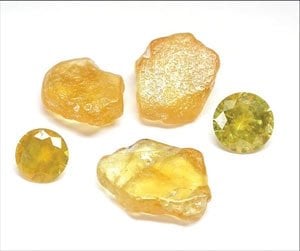RedSpinel
Shiny_Rock
- Joined
- Apr 28, 2012
- Messages
- 211
I first noticed this phenomenon about 7 years ago I guess, as I was browsing the internet for stones. I'd keep seeing this sudden, high volume of "Padparadscha" sapphires, and I was both puzzled and skeptical. It was hard to belive that there were all these seemingly cheap Padparadschas all over the internet! Plus, they didnt exactly fit the typical color I'd become accustomed to seeing in Pad, sapphires.
Soon after I read about what was happening here. Its been years now, but basically I read that some gem owner was trying to heat treat some sapphires, when he accidentally left some Beryl of one variety or another mixed in with the sapphires. Then while heating them, the proper heat for sapphires rose above the vapor temp of beryl, so the beryl vaporized, and chemically bonded with the sapphires, giving them a new, different color. At first they didnt know what had happened, but then they figured it out, and it became common practice for certain sapphires.
I guess that brings us to Songea sapphires. I read that these stones from a region of Africa would come out of the ground as unattractive rough, with poor color. But they used the Be heat method to "improve" the color of these so called Songea sapphires, and thats how we got these new color sapphires on the market.
They come in colors like pinkish-red, bright orange, deep golden yellow, etc. That brings me to question #1. With the pinkish red Songea sapphires, there were regularly these odd, black, ink-blot inclusions inside them! The funny thing was that these inclusions of that ink-blot style didnt show up in the other colored Songea sapphires, so the pink-ish red ones must be from another mine area than the other colored songea sapphires. I dont see those black spots in the orange ones or gold ones. Whats up with that?
That was a shame, because I thought the pinkish-red ones were by far the prettiest, but they usually had those obvious, ugly inclusions. So I bought a few fairly large orange and yellow ones at good prices, which are very clean. I have a 2ct orange, a 2.7ct orange, and a 3.7ct orange one. A few 1+ ct size yellows, as well as a couple natural yellows. I know they arent worth as much as either a heat-only sapphire or certainly not as much as a non-treated sapphire, but they were pretty cheap and nice looking, so.........
\What do you think of them, have you bought any, and how much are they worth? How stable are they, and is there any "special" treatment that they need in order to not be damaged? I know that the color is only "skin deep" with these things.....
Soon after I read about what was happening here. Its been years now, but basically I read that some gem owner was trying to heat treat some sapphires, when he accidentally left some Beryl of one variety or another mixed in with the sapphires. Then while heating them, the proper heat for sapphires rose above the vapor temp of beryl, so the beryl vaporized, and chemically bonded with the sapphires, giving them a new, different color. At first they didnt know what had happened, but then they figured it out, and it became common practice for certain sapphires.
I guess that brings us to Songea sapphires. I read that these stones from a region of Africa would come out of the ground as unattractive rough, with poor color. But they used the Be heat method to "improve" the color of these so called Songea sapphires, and thats how we got these new color sapphires on the market.
They come in colors like pinkish-red, bright orange, deep golden yellow, etc. That brings me to question #1. With the pinkish red Songea sapphires, there were regularly these odd, black, ink-blot inclusions inside them! The funny thing was that these inclusions of that ink-blot style didnt show up in the other colored Songea sapphires, so the pink-ish red ones must be from another mine area than the other colored songea sapphires. I dont see those black spots in the orange ones or gold ones. Whats up with that?
That was a shame, because I thought the pinkish-red ones were by far the prettiest, but they usually had those obvious, ugly inclusions. So I bought a few fairly large orange and yellow ones at good prices, which are very clean. I have a 2ct orange, a 2.7ct orange, and a 3.7ct orange one. A few 1+ ct size yellows, as well as a couple natural yellows. I know they arent worth as much as either a heat-only sapphire or certainly not as much as a non-treated sapphire, but they were pretty cheap and nice looking, so.........
\What do you think of them, have you bought any, and how much are they worth? How stable are they, and is there any "special" treatment that they need in order to not be damaged? I know that the color is only "skin deep" with these things.....




300x240.png)